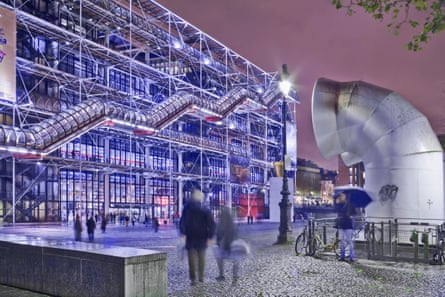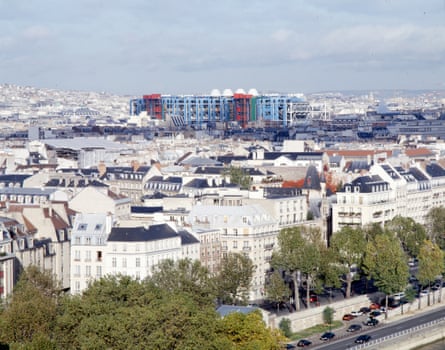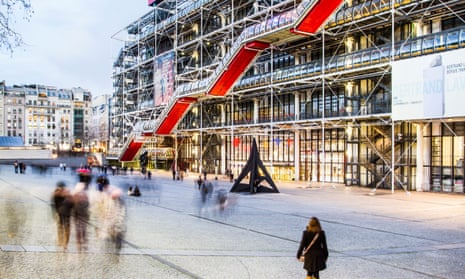At a press conference in the Élysée Palace, in 1971, President Georges Pompidou was so properly turned out that the soles of his shoes were polished. The hairy young crew who had just won the competition to design the arts centre that would carry his name, beating 680 others, were not. Richard Rogers wore a railwayman’s blue denim suit and a flower power shirt, Renzo Piano a hippiefied combination of beard and tweeds and their partner John Young a sweatshirt that (memories would vary) may have had Mickey Mouse on it. Only Ted Happold, of the engineers Ove Arup, wore a suit and tie. “You are the capitalist,” the president told him.
This tableau captured the grand bargain between radical architecture and establishment politics that generated the famous building that would follow, the Pompidou Centre, sometimes called the Beaubourg, whose 40th birthday is about to be trumpeted with 50 exhibitions and 15 concerts and performances in 40 different cities – an André Breton show in Lille, for example, and an Alain Buffard dance piece in Nimes. And with the passage of time it only stands out more. It has claims to be the most significant single building since the war. It is both a late blossoming of the 1960s and a precursor of the city-boosting “iconic” architecture of the decades since. It is a palace for a media-soaked age, as bright in its reds and blues as colour TV and colour supplements.
In 1968, three years before the memorable press conference, the Paris streets in which the centre now stands had been ripped up by protesting students. Pompidou became president the following year – a conservative with a mission to restore order, who also planned a series of transformative building projects for Paris. Among them was a proposal for a centre of contemporary arts – not just a museum or a gallery, but also a library and a centre for music. His motives would have included a wish to tame the city with a sophisticated form of bread and circuses. As Piano now says: “After 1968, he had to do something, to show something.”
Piano says that he and Rogers, in their early 30s, were by the standards of their slow-maturing profession “teenagers, young boys”. “When you are that young, you are innocent. What you do is what you feel.” Their proposals “were an exercise in freedom, not guided by any desire to win or compromise”. What was exceptional was that “a powerful political man like Pompidou” should run an open competition that could be won by such a team. “It was a really brave idea. The point was to make people like us do something like that.”

They “stood on the shoulders”, as Rogers says, of architects such as Archigram and Cedric Price, who over the previous decade had conceived visions, largely unbuilt, of a kind of architecture that would use technology to change and move, and would embrace the gaudy glamour of film and advertising. For the Beaubourg competition, Piano, Rogers and their colleagues imagined a big frame with pipes and structure on the outside to leave the interior unencumbered and adaptable. Parts of the building could be clipped and unclipped in response to future needs. Its floors would move up and down. Huge electronic screens would interact with crowds in a piazza outside and escalators in glass tubes would transport people towards the sky. “CAROLINE,” ran a message on a screen in one of the drawings, “GO TO KANSAS CITY IMMEDIATELY YOUR FRIEND LINDA HAS BEEN BUSTED”.
It wasn’t supposed to be a monument but an event, a happening. Piano now also describes it as “not a building but a town where you find everything – lunch, great art, a library, great music”. The point was, as Rogers puts it, that “culture should be fun”. “After decades of museums being dusty, boring and inaccessible,” says Piano, “someone had to run away, to do something different, have a sense of participation. Someone had to express that rebellion. Putting this spaceship in the middle of Paris was a bit mad but an honest gesture. It was brave but also a bit impolite, for sure.”
It nearly didn’t happen, first because Rogers wrote what Piano calls “a beautiful little memo”, arguing that they shouldn’t enter a competition for what he thought would be “a rhetorical gesture of grandeur”.
“We were very democratic people and discussed it,” says Piano, but the composition of the competition jury changed their mind. It included the designer Jean Prouvé, a man more concerned with things like low-cost housing than monument building, so “we saw that it might also be about ethics, people, society. We were young but we were not stupid. We saw some sign of a possible miracle.”

He ascribes their victory to various factors: that they proposed a piazza, for example, rather than covering the whole site with building. Also, that “there was a clarity in our proposal, in someone saying with a degree of rebellion, ‘Hang on, what is culture?’ It changes continuously, every 25 years, so we want a flexible space.” Faced with 681 entries, he guesses, “you might get confused, then say, ‘Oh shit, this one is not stupid’”. He believes that there was “something in the air”, that their ideas caught the spirit of the time. He also thinks that “the stars, the planets, the satellites were all found in the right position”.
Having won, they embarked on the exhilarating process of getting the dreams built, which, despite the guidance of the large, established firm of Arup, was also, says Rogers, “the most difficult thing I have ever done. There were lawsuits against us and all sorts of rules and regulations. There were many, many crises.”
Pompidou died before completion and his successor, Giscard d’Estaing, after contemplating cancelling the project, slashed the budgets. Not all the original ideas survived the process. The information screens were dropped. The floors didn’t move. Fire regulations caused transparent walls to be made opaque and elegant bits of structure to be swaddled in protective material.

Up to and including its opening on 31 January 1977, the Pompidou received the critical response traditional for buildings that go on to be much-loved landmarks: the Guardian’s art critic wanted this “hideous” object covered with Virginia creeper. “Paris has its own monster,” said Le Figaro, “just like Loch Ness.” In its defence Rogers pointed to the hostility the Eiffel Tower provoked when it was new. “Making change is not easy” says Piano.
But it was a popular success. Crowds and impromptu street entertainers gathered in the piazza. Visitor numbers were five times predictions. The escalators were a hit. Because of the uniform roof heights of most of Paris’s buildings, and the fact that the Pompidou Centre rises above its neighbours, sweeping views unfolded as you rode to the top. It enabled citizens to take possession of their city. “It was necessary,” believes Piano, to create a building of this type at this time, “and because it was necessary it became accepted.”
Sadly, since the Pompidou reopened in 2000, after a two-year refit, the escalators are no longer free to enter, which diminishes their role in making the centre into a popular fun palace and connecting its life with that of the city. The art inside now feels more remote from that of the street, but the Pompidou remains successful for the same reasons as when it was first built. It’s partly the energy, joy and bravado palpable in its construction, which you don’t have to be an expert in architecture to sense. It’s partly the simple, somewhat traditional but effective relationship of building to public space – a palace in front of a piazza, like something from renaissance Italy. Mostly, it’s the surprising and mutually enriching combination of the two. A radical building in a radical urban plan, or a conventional building in a conventional one, would not be as powerful.
At the same time, it’s a building with flaws and contradictions, whose theoretical rhetoric doesn’t stand too much scrutiny. Exposing the pipes and ducts on the outside doesn’t actually make it easier to maintain and alter but multiplies by a large factor the amount of surface exposed to the weather. The idea of clipping elements on and off has proved largely a fantasy. Much of the detailing is beautifully considered, which is nice, but runs counter to the ethos of spontaneity.
Logic and consistency are not what the building is about. Piano later admitted that it would have been cheaper and more efficient to have put a row of columns down the centre of the building. There would have been no need for enormous trusses and little impact on the design ideals, except that, in Piano’s view, a concession on this point would have put the building on a slippery slope whereby a series of pragmatic decisions would have diluted its spirit to the point where there was nothing left.
Much of the Pompidou’s appeal is about how it looks, which is not to say it doesn’t change anything. If Paris now had no such building, it would suffer more from the ossification that, in truth, is one of its weaknesses. The city would be more of a museum piece. And it is in this way, as a magically transformative cultural building, both popular and progressive looking, with the power to boost a city or change its image, that the Pompidou has been most influential.
This is a lot about the relation of building to mass media, with which the architects were fascinated from the start. If the unrealised big screens were to have generated an interaction of people and information of a kind now made commonplace by smartphones, the main impact was more direct. Simply by being a large memorable, striking thing, it makes itself known to audiences who haven’t seen it in the flesh. It helps that it is visibly inhabited – not just a bizarre object but one around which you can imagine yourself moving.

The Pompidou’s descendants include the grands projets – the Pyramid in the centre of the Louvre, the Grande Arche at La Défense – that later French presidents built in Paris and ambitious mayors built in French cities. Then the Guggenheim in Bilbao and the very many would-be icons, from brilliant to catastrophic, that followed. Many of the architects and engineers involved went on to have eminent and influential careers. Renzo Piano and Richard Rogers, going their separate ways, would give the world airports, skyscrapers, parliaments, art galleries.
At its best, the Pompidou concept is about celebrating the life of cities and bringing energy to their centre – and in the 1970s, through a combination of flight to the suburbs and destructive planning, traditional cities seemed endangered and in need of such support. It works through bold and optimistic architecture and direct devices, like the escalators and the plaza.
At its worst, it leans too heavily on too vague notions of “progressive” and “creative” design. The same rhetoric, applied to the Millennium Dome or some of the commercial projects that Piano and Rogers now design, can be less convincing. The Eiffel Tower argument, that posterity will vindicate anything new and startling, gets wheeled out to justify almost anything. It gets forgotten that there is intelligence in the Pompidou design, in the way it responds to a historic city, for example, as well as spectacle and novelty.
Piano is confident about the building’s future. “We believe that the life of this building will be 2,000 years so we don’t care so much about 40 years. The Colosseum is still there so I don’t see why it won’t be still there.”
His Paris office is round the corner from the centre, so he sees it almost every day that he is in the city. He visits it frequently. “I am the Quasimodo of Beaubourg,” he says. “Every single bolt of the building, I have a sense of why it’s there. And when I see it now I wonder how they could ever have allowed us to do something like that.”

Comments (…)
Sign in or create your Guardian account to join the discussion